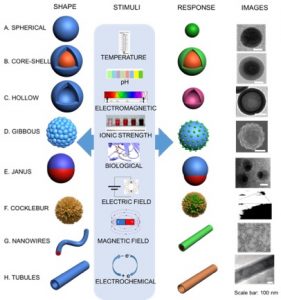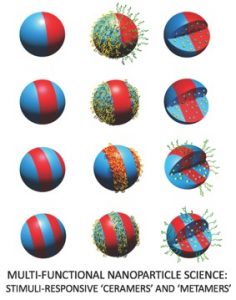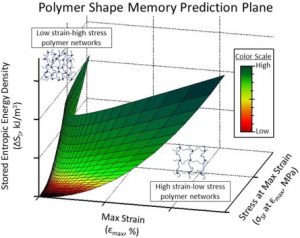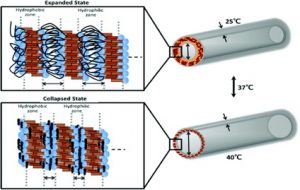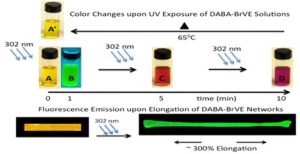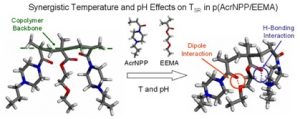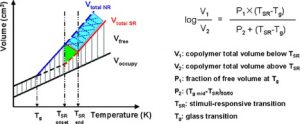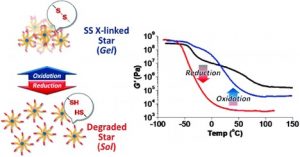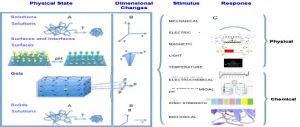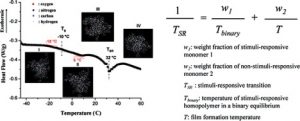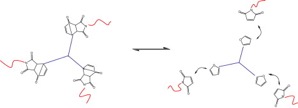C. Lu, M.W. Urban, “Stimuli-responsive polymer nano-science: shape anisotropy, responsiveness, applications” Prog. Polym. Sci., 2017, http://dx.doi.org/10.1016/ j.progpolymsci.2017.07.005Y.
ABSTRACT
Polymeric nanomaterials capable of altering volume, color, or shape have attracted significant scientific interests as these materials become increasingly critical in advancing unique technological developments. Design, synthesis, and assembly of nanomaterials with precisely controlled shapes and directional responsiveness are particularly critical in the development of new functional, near-device level materials. Spatial anisotropies are typically introduced by the placement of symmetrically or asymmetrically located responsive components enabling either interactions with the environment manifested by dimensional or color changes, energy storage and transfer, or diffusion. This review outlines recent advances in the synthesis, fabrication, and assembly of isotropic and anisotropic polymer-based nanomaterials in which dimensional, color, and morphological changes are induced by external stimuli. Specifically, core-shell, hollow, Janus, gibbous/inverse gibbous nanoparticles prepared with precisely controlled morphologies capable of spatially responding totemperature, pH, electromagnetic radiation or biological changes are discussed. Recent advances in the nanoparticle surface modifications which are introduced to guide nanomaterials to selectively interact and communicate with the environment are also highlighted. Since high aspect ratio nanomaterials, including polymeric nanowires or nanotubes containing responsive components, are particularly attractive in the development of 3D multi-functional objects, their manufacturing as well as applications are examined. Although many uses of stimuli-responsive nanomaterials in electronics, energy conversion, sensing, or biomedicine and other technologies are already in place, there are limitless opportunities for new applications as long as proper regulatory measures are exercised to elevate the impact of these materials on the environment. Polymeric stimuli responsive nanomaterials offer a tremendous opportunity for the development of cognitive materials’ systems, particularly when protein-like polymers containing amino acids joined by polypeptide bonds with enzymes or sugarphosphate moieties as well as other sugar-containing interactions are utilized as building blocks and components of future materials.
X. Liu, Y. Yang, M.W. Urban “Stimuli-Responsive Polymeric Nanoparticles,” Macromol. Rapid Commun., 2017, 7, DOI:10.1002/marc.201700030.
ABSTRACT
There is increasing evidence that stimuli-responsive nanomaterials have become significantly critical components of modern materials design and technological developments. Recent advances in synthesis and fabrication of stimuli-responsive polymeric nanoparticles with built-in stimuli-responsive components (Part A) and surface modifications of functional nanoparticles that facilitate responsiveness (Part B) are outlined here. The synthesis and construction of stimuli-responsive spherical, core-shell, concentric, hollow, Janus, gibbous/inverse gibbous, and cocklebur morphologies are discussed in Part A, with the focus on shape, color, or size changes resulting from external stimuli. Although inorganic/metallic nanoparticles exhibit many useful properties, including thermal or electrical conductivity, catalytic activity, or magnetic properties, their assemblies and formation of higher order constructs are often enhanced by surface modifications. Section B focuses on selected surface reactions that lead to responsiveness achieved by decorating nanoparticles with stimuli-responsive polymers. Although grafting-to and grafting-from dominate these synthetic efforts, there are opportunities for developing novel synthetic approaches facilitating controllable recognition, signaling, or sequential responses. Many nanotechnologies utilize a combination of organic and inorganic phases to produce ceramic or metallic nanoparticles. One can envision the development of new properties by combining inorganic (metals, metal oxides) and organic (polymer) phases into one nanoparticle designated as “ceramers” (inorganics) and “metamers” (metallic).
C. Hornat, Y. Yang, M.W. Urban, “Quantitative Predictions of Shape-Memory Effects in Polymers,” Adv. Mater., 2017, DOI:10.1002/adma.201603334.
ABSTRACT
Shape memory polymers offer unique properties that are critical to the future of advanced materials. In an effort to effectively utilize the ability of shape recovery, these studies utilized dynamic and static forces during dynamic mechanical analysis (DMA) to quantify shape memory effects (SME) in polymers. These studies identified the basis for glass transition temperature-based (Tg) SME and showed unique shape memory transitions that are macroscopically manifested by directional extension and subsequent retraction in thermoplastic and thermosetting polymers. While viscous components of the network at the onset of the Tg are responsible for material’s extension, the retractions result from stored conformational entropy as a result of crosslink density and/or chain entanglements. This behavior was quantified in terms of stored (ΔSS) entropic energy density, which combines stress and strain aspects of shape recovery. In contrast to traditional strain recovery and fixation ratios, the proposed approach encompass the maximum strain (εmax), stress (σSF at εmax), and energy storage (ΔSS) by considering physical polymer architecture, molecular weight, molecular weight distribution, and viscoelastic behavior, thus allowing quantitative assessments of the SME from a single DMA experiment. This concept can be extended to determine the SME in glassy and amorphous inorganic materials for any material that exhibits the Tg and the rubbery plateau above the Tg.
S. Kawano, M. W. Urban, “Expandable Temperature-Responsive Polymeric Nanotubes,” ACS Macro Lett., 2012, 1 (1), 232-235.
ABSTRACT
Materials with the ability of dimensional changes on demand exhibit many potential applications ranging from adaptive composites that mimic biological functions under extreme conditions to microfluidics or neural implants to stimulate components of the nervous systems. These studies show the synthesis of temperature-induced reversibly expandable nanotubes that were prepared by polymerization of N-isopropylacrylamide (NIPAAM) in the presence of biologically active 1,2-bis(tricosa-10,12-diynoyl)-sn-glycero-3-phosphocholine (DC8,9PC) diacetylenic phospholipids (PL). As a result, thermally responsive poly-NIPAM-phospholipid nanotubes (PNNTs) were prepared. Polymerization reactions occur within hydrophilic regions of PL bilayers, whereas PL hydrophobic zones facilitate transport and supply of the monomer for polymerization. The unique feature of PNNTs is that, above 37 °C, the outer diameter (OD) as well as the wall thickness (WT) shrink by 20 and 55%, respectively, whereas the inner diameter (ID) increases by ∼16%. This behavior is attributed to the PNIPAM backbone buckling induced by local rearrangements within PL bilayered morphologies. The presence of acetylenic moieties along the PL bilayers in PNNTs provides an opportunity for irreversible “locking” of designable dimensions, which is facilitated by the formation of cross-linked PNNTs (CL-PNNTs).
D. Ramachandran, M.W. Urban “Sensing Macromolecular Rearrangements in Polymer Networks by Photochromic Crosslinkers,” Special Issue on Mechano-Responsive Polymers; J. Mat. Chem., 2011, 21, 8300-8308.
ABSTRACT
A new family of azobenzene crosslinked brominated vinyl ester (DABA-BrVE) polymernetworks was developed that exhibits reversible photochromic and fluorescence properties in which azobenzene serves as a crosslinker as well as a molecular sensor of structural and conformational changes of the surrounding macromolecular segments. The covalently “build-in” azobenzene crosslinker functions as a light emitting group capable of sensing stresses or damages, thereby altering photochromic and fluorescence properties. These reversible processes induced by structural network rearrangements may offer numerous application possibilities ranging from molecular stress sensors or nano-crack detectors in composites and other materials.
F. Liu, M.W. Urban, “Synergistic Temperature and pH Effects on Stimuli-Responsive Transitions in poly(N-Acryloyl-N’-Propylpirerazine-co-2-Ethoxyethyl Methacrylate) Copolymers” Polym. Chem., 2011, 2, 963-969.
ABSTRACT
N-Acryloyl-N′-propylpiperazine (AcrNPP) and 2-ethoxyethyl methacrylate (EEMA) monomers were copolymerized to form random stimuli-responsive p(AcrNPP/EEMA) copolymers in a form of colloidal dispersions which upon coalesce form uniform films. The presence of AcrNPP units facilitates temperature and pH responsiveness, thus resulting in composition-dependent and pH-temperature sensitive endothermic transitions: the glass (Tg) and stimuli-responsive (TSR) transitions. These studies show that the relationship between the newly discovered TSR and known Tg relaxations can be predicted by the following formula: 1/TSR = [Tg1 × Tg2 × (Tbinary − T)]/[Tbinary × T × (Tg1 − Tg2) × Tg] + (Tg1 × T − Tbinary × Tg2)/[Tbinary × T × (Tg1 − Tg2)], where TSR is the stimuli-responsive transition temperature, Tg is the glass transition temperature of the copolymer; Tbinary is the temperature of stimuli-responsive homopolymer in a binary polymer-water equilibrium, Tg1 and Tg2 are the glass transition temperatures of stimuli-responsive and non-stimuli-responsive homopolymers, respectively, and T is the film formation temperature. Experimental spectroscopic and differential scanning calorimetry (DSC) evidence showed that dipole-dipole interactions are responsible for the molecular changes at the TSR for a non-protonated state, and the shift of the TSR under protonated conditions is attributed to the synergistic pH and temperature effects associated with H-bonding and conformational backbone and side chain rearrangements. Computer simulations also showed that the buckling of the copolymer backbone and collapse of propylpiperazine groups occur above TSR. The total energies (ΔEtotal) of the TSR transitions for protonated and non-protonated states are 159 and 132 kcal mol−1, respectively, and are in good agreement with the energy values determined experimentally (DSC).
M.A.C. Stuart, W.T.S. Huck, J. Genzer, M. Müller, C. Ober, M. Stamm, G.B. Sukhorukov, I. Szleifer, V.V. Tsukruk, M.W. Urban, F. Winnik, S. Zauscher, I. Luzinov, S. Minko, “Emerging applications of stimuli-responsive polymer materials” Nature Materials, 2010, 9(2), 101-113.
ABSTRACT
Responsive polymer materials can adapt to surrounding environments, regulate transport of ions and molecules, change wettability and adhesion of different species on external stimuli, or convert chemical and biochemical signals into optical, electrical, thermal and mechanical signals, and vice versa. These materials are playing an increasingly important part in a diverse range of applications, such as drug delivery, diagnostics, tissue engineering and ‘smart’ optical systems, as well as biosensors, microelectromechanical systems, coatings and textiles. We review recent advances and challenges in the developments towards applications of stimuli-responsive polymeric materials that are self-assembled from nanostructured building blocks. We also provide a critical outline of emerging developments.
F. Liu, D. Ramachandran, M. W. Urban,”Colloidal Films That Mimic Cilia” Adv. Funct. Mater., 2010, 20(18), 3163–3167.
ABSTRACT
Cilia are wavy hair-like structures that extend outward from surfaces of various organisms. They are classified into two general categories, primary cilia, which exhibit sensing attributes, and motile cilia, which exert mechanical forces. A new poly(2-(N,N-dimethylamino)ethyl methacrylate-co-n-butyl acrylate-co-N,N-(dimethylamino) azobenzene acrylamide) (p(DMAEMA/nBA/DMAAZOAm) copolymer is prepared using colloidal synthesis, which, upon coalescence, form films capable of generating surfaces with cilia-like features. While film morphological features allow the formation of wavy whiskers, the chemical composition of the copolymer facilitates chemical, thermal, and electromagnetic responses manifested by simultaneous shape and color changes as well as excitation wavelength dependent fluorescence. These studies demonstrate that synthetically produced polymeric films can exhibit combined thermal, chemical, and electromagnetic sensing leading to locomotive and color responses, which may find numerous applications in sensing devices, intelligent actuators, defensive mechanisms, and others.
F. Liu, W.L. Jarrett, M.W. Urban, “Glass (Tg) and Stimuli-Responsive (Tsr) Transitions in Random Copolymers” Macromolecules, 2010, 43(12), 5330-5337.
ABSTRACT
In an effort to elucidate the origin of stimuli-responsive (TSR) transitions and correlate them to the glass transition temperature (Tg), poly(N-acryloyl-N′-propylpiperazine-co-2-ethoxyethyl methacrylate) (p(AcrNPP/EEMA)), poly(N-vinylcaprolactam-co-n-butyl acrylate) (p(VCl/nBA)), poly(N-isopropyl methacrylamide-co-n-butyl acrylate) (p(NIPMAm/nBA)), and poly(2-(N,N′-dimethylamino)ethyl methacrylate-co-n-butyl acrylate) (p(DMAEMA/nBA)) colloidal dispersions were synthesized, which upon coalescence form solid films. These studies showed that molecular rearrangements responsible for the TSR transitions are attributed to the backbone buckling and collapse of stimuli-responsive components. Based on empirical data, the relationship between Tgand TSR was established: log(V1/V2) = (P1(TSR − Tg))/(P2 + (TSR − Tg)), where the V1 and V2 are the copolymer total volumes below and above the TSR, respectively, Tg is the glass transition temperature of the copolymer, and P1 and P2 are the fraction of the free volume (ffree) at Tg (P1) and (Tg,midpoint − TSR)50/50) for each random copolymer (P2), respectively. This relationship can be utilized to predict the total volume changes as a function of TSR − Tg for different copolymer compositions. To our best knowledge, this is the first study that provides the relationship between the TSR, Tg, free volume, chain mobility, and dimensional changes in stimuli-responsive random copolymer networks.
J. Kamada, K. Koynov, C. Corten, A. Juhari, J. A. Yoon, M. W. Urban, A. C. Balazs, K. Matyjaszewski, “Redox Responsive Behavior of Thiol/Disulfide-Functionalized Star Polymers Synthesized via Atom Transfer Radical Polymerization” Macromolecules, 2010, 43(9), 4133-4139.
ABSTRACT
A poly(n-butyl acrylate)-based star polymer, polyEGDA-(polyBA)n, was synthesized by atom transfer radical polymerization using a modified core-first method. Further polymerization of a disulfide (SS) cross-linking agent bis(2-methacryloyloxyethyl) disulfide from the arm end produced a SS cross-linked star polymer. The disulfide functionality could be cleaved via reducing reactions, generating individual stars containing SH groups at the chain ends. The transformation between SS cross-linked star and SH-star was reversible via repetitive reduction and oxidation. Dynamic light scattering measurements showed that the average diameter of the cleaved star polymer was around 20 nm. The dynamic mechanical properties of these star copolymers were characterized through examination of the temperature dependencies of their shear moduli. The results showed that SS-functionalized star polymers respond to reduction−oxidation conditions, indicating that the disulfide bonds do cleave and re-form. These stimuli responsive star polymers have potential utility as intelligent polymeric materials such as self-healing materials.
F. Liu, M.W. Urban, “Recent Advances and Challenges in Designing Stimuli-Responsive Polymers” Prog. Polym. Sci., 2010, 35(1-2), 3-23.
ABSTRACT
Synthetic materials capable of responses to external or internal stimuli represent one of the most exciting and emerging areas of scientific interest and unexplored commercial applications. While there are many exciting challenges facing this field, there are a number of opportunities in design, synthesis, and engineering of stimuli-responsive polymeric systems and Mother Nature serves as a supplier of endless inspirations. This review examines physico-chemical requirements necessary to achieve stimuli-responsiveness in heterogeneous polymer networks as well as discusses recent developments and future trends. While individual structural components of polymeric networks are responsible for localized chain-responsiveness, desirable spatial and energetic network properties are necessary for collective and orchestrated responsiveness to external or internal stimuli. These attributes significantly vary for stimuli-responsive polymeric solutions, surfaces and interfaces, polymeric gels, and solid networks.
F. Liu, M. W. Urban, “New Thermal Transitions in Stimuli-Responsive Copolymer Films” Macromolecules, 2009, 42(6), 2161-2167.
ABSTRACT
These studies report new thermal relaxations in stimuli-responsive solid-phase copolymers detected by differential scanning calorimetry (DSC) and dynamic mechanical analysis (DMA). When 2-(N,N-dimethylamino)ethyl methacrylate (DMAEMA) and n-butyl acrylate (nBA) monomers were copolymerized into colloidal dispersions and allowed to coalesce to form solid continuous films, in addition to the glass-transition temperature (Tg), which follows the Fox equation for random copolymers, a new composition-sensitive endothermic stimuli-responsive transition (TSR) was observed. The TSR transition changes with the composition of the stimuliresponsive component of the copolymer, the temperature, and the rate of temperature change. On the basis of the experimental data, the following relationship was established: 1/TSR ) w1/Tbinary + w2/T or 1/TSR ) w1(1/Tbinary – 1/T) + 1/T, where TSR is the temperature of the stimuli-responsive transition, Tbinary is the temperature of the stimuli-responsive homopolymer in a binary polymer-water equilibrium, w1 and w2 (w2 ) 1 – w1) are weight fractions of each component of the copolymer, and T is the film-formation temperature. This relationship allows us to predict TSR transitions in stimuli-responsive solid copolymers. The enthalpic (∆H) components of the Tg and TSR transitions determined from DSC measurements are 122 kcal/mol for Tg and 199 kcal/mol for TSR, which are part of the total energy, ∆Etot, of the system. The calculated values of the ∆Etot obtained using computer modeling simulations (168 kcal/mol for Tg and 223 kcal/mol for TSR, respectively) are in good agreement with the experimental data, and the energy difference is attributed to the inclusion of the entropic components in ∆Etot calculations.
N.Aumsuwan, M.W. Urban, “Reversible Releasing of Arms from Star Morphology Polymers” Polymer, 2009, 50(1), 33-36.
ABSTRACT
Reversible thermally induced arm release from a star polymer morphology was prepared which consists of furanic functional core and maleimide functional arm which are attached or detached via Diels-Alder (DA) reversible reactions. This approach allows the reversible bonding and debonding at 35-40 °C (DA) and 90-100 °C (retro-DA). The covalent reversibility of this process consists of 7 cycles of the DA and retro-DA reactions.
M.W. Urban, “Stratification, Stimuli-Responsiveness, Self-healing, and Signaling in Polymer Networks” Prog. Polym. Sci., 2009, 34(8), 679-687.
ABSTRACT
The design, development, and manufacturing of new materials continue to be an ongoing challenge for scientists and engineers. Because of similarities to biological systems having self-repairable properties, polymer networks are of particular importance and interest, and if designed properly, may provide an unprecedented opportunity for mimicking biological systems. This can be accomplished through the formation of nanostructured stimuli-responsive networks that individually or collectively respond to internal or external stimuli. This article outlines selected recent developments and future trends that will formulate foundation for the development of stratified heterogeneous stimuli-responsive polymer networks capable of reorganizing, self-healing, or signaling. The primary focus is on the physico-chemical attributes of multi-component polymer networks with localized glass transition temperatures capable of stratification and exhibiting stimuli-responsiveness or recognition attributes.

